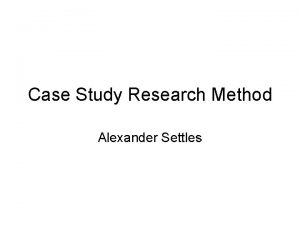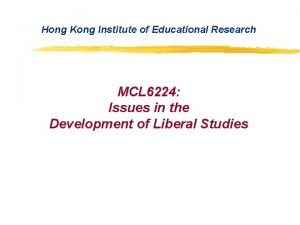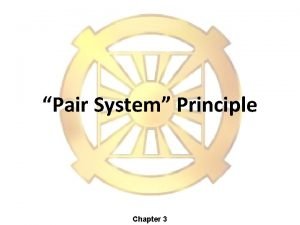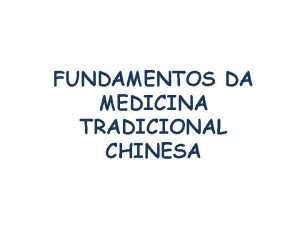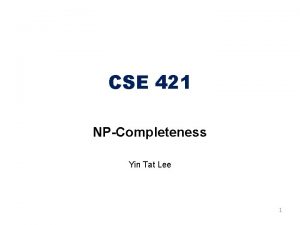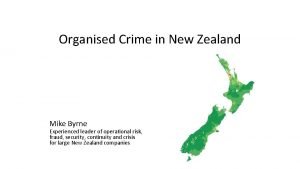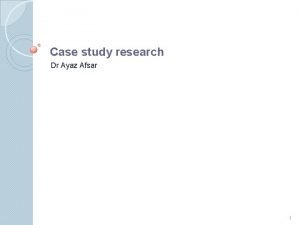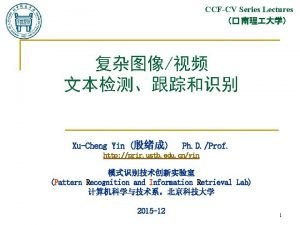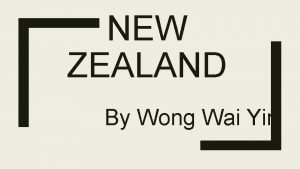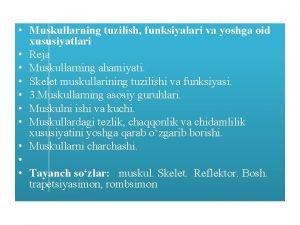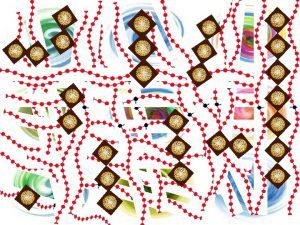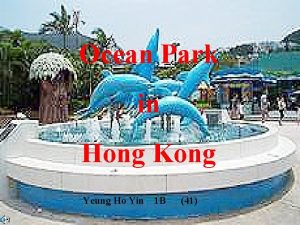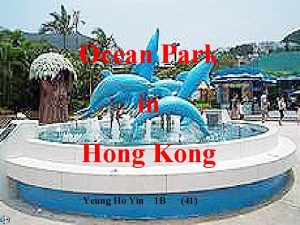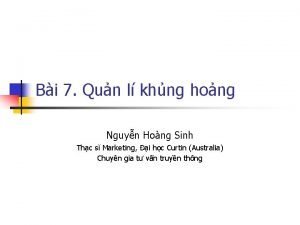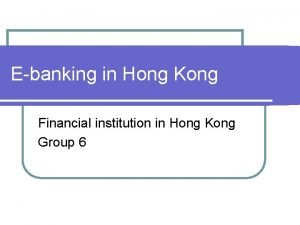Environmental Risk Analysis Research Yin Hong Environmental Risk


























- Slides: 26

Environmental Risk Analysis Research Yin Hong Environmental Risk Analysis Research Program, ICBC -1 -1 -

Content 1. Overview 1. Background 2. Green Credit 2. Green 2. Stress Credit test System 3. Typical Cases 3. Typical 3. ESG Rating Cases

1. 1 Background q Climate change, environmental and resource constraints have been becoming global issues. q In China, after more than 30 years’ high-speed development, the problems of environment pollution and high resource consumption are becoming increasingly prominent. The environmental risk confronting enterprises keeps growing and mass disturbances happen occasionally. These factors bring the commercial banks pay more attention to environmental and reputational risk than in the past. q China has already included the “ecological civilization construction” as part of national strategy, it’s expected that the environmental emission standards would be tightened constantly, and the credit risk of traditionally heavy polluting sectors would be becoming more significant in the future. q This stress testing is one major task of the Green Finance Committee of China Society for Finance and Banking. At the request of the Committee, ICBC has launched the stress testing program since the beginning of 2015. q Besides the stress testing , ICBC also developed the ESG Index. -3 -

1. 2 Significances 1 Quantify the effect of environmental factors on credit risk. Environmental Risk Analysis 4 55 2 Provide methodology for pricing of credit and investment products acounting environmental risk. 3 Help banks adjust credit, investment portfolio& other business structure. Offer a tool for quantification of environmental risk so as to divert funds to green investment. Providea areferencefor forbankingregulatorswhentheyconsider Provide a a reference for banking regulators when they consider environmental risks. -4 - 4

1. 3 ICBC Released the Stress Testing Study q On 23 rd March 2016, ICBC released the achievements from the “Study on the Stress Testing for the Impact of Environmental Factor on Credit Risk of Commercial Banks” at the “The future of green finance international event” in London. Andrew voysey says , this has powerful implications for firms of all types. As knowledge and methodologies develop to enable financial institutions to factor environmental risks into decisions about where they put their money, firms seeking to raise debt, maintain their equity value or buy insurance may increasingly find that their management of environmental factors is a decisive factor in their cost of , or even access to , capital. Sean Kidney, CEO and cofounder of the Climate Bond Initiative , said the ICBC research is helpful to accelerate global growth of the green-finance market. Mats Olausson , senior adviser of climate and sustainable financial solutions at the SEB, said “what ICBC has done is applaudable, and highlights the fact that increasingly the financial industry needs to consider sustainabiliy in their day to day activities. ” -5 -

1. 4 Difference Between Stress Test and ESG Index forcasting future stress test ESG Rating hypothetical senarios reflect the past truthful data -6 -

Content 1. Overview 1. Background 2. Green Credit 2. Green 2. Stress Credit test System 3. ESG Rating 3. Typical Cases

2. 1 Notions Climate and environment problems have distinct externalities. Both external economy and external diseconomy generated from environment changes can be converted into endogenous variables in the production and operation of enterprises. The internalized enterprise environment cost will impact the risks of commercial banks. environmental factors will exaggerate business risk of commercial banks in at least three ways: 1、credit risk 2、the risk of taking a joint liability 3、reputation risk Relatively, the credit risk, as the main risk confronted by commercial banks, is considered as the focus of our research project.

2. 2 Model A model to illustrates the impact of environmental risk on enterprises and banks’ lending risk. : enterprise’s loan demand : lending rate : environmental risk : bank loans : deposit rate : lending rate Relationship between Risk Exposure of Bank Loans and Environmental Risk : environmental risk -9 -

2. 3 Basic process Stress test`s 6 steps: 1. selecting the portfolios to be tested; 2. selecting the stress factors and indicators to be applied; 3. selecting stress-bearing objects and determining stress-bearing indicators; 4. building scenarios; 5. constructing the transmission model; 6. performing the stress test and analysing results Flow Chart of Stress Test: -10 -

2. 4 Methodology Firstly, We begin our stress testing in cement industry and thermal power industry, which are among the higher pollution and higher energy comsuption industries in China. Secondly, we measure the impact of stricter environmental standards on enterprises` unit cost, under three different scenarios: mild, moderate, severe. Ø In terms of cement industry , we take 3 aspects policies into acount, including on emissions standards enhancement, sewage charges standard improvment, waste disposal assistance. Ø In terms of thermal power industry,we take acount 3 aspects policies, including on emissions standards enhancement, sewage charges standard improvment, the difference of regional standards. Thirdly, conduct stress test in ICBC’S financial transmission model. we measure the impact of enterprises' unit cost increase on credit rating, probability of default (PD) and non-performing loan ratio (NPLR) for those two industries -11 -

2. 5 case study: Thermal Power With regards to thermal power industry, the research group constructed heavy, medium and light stress scenarios for the energy saving and emissions reduction of thermal power firms according to : the standards released by the Ministry of Environmental Protection(end of 2014), the standards of the State Council(end of 2015), and the special limits for easternareas released by the State Council (end of 2020). Based on that, the impact of increasing pollutant discharge fees by four, three and two times on firm costs was taken into consideration. -12 -

2. 5 case study: Thermal Power -13 -

2. 5 case study: Thermal Power Results: 1、stricter environmental protection standards impose great cost pressure on thermal power industry, but the industry will maintain stable on the whole, owing to the steady growth of the macroeconomy and huge demand for electricity generated in the process of China’s industrialization. 2、enhanced environmental protection standards will have major structural impact on thermal power industry; particularly, small and mediumsized firms (SMEs) will be confronted with obvious financial pressures, -14 -

2. 5 case study: Thermal Power Policy recommendations: the first is to maintain existing AAA customers and continue to attract new highquality customers from the five major power companies. The second is to pay attention to the impact of changes in environmental protection policy on the financial cost and credit risk of firms with the rating of AA+ and below, especially the corporate customers with the possibility of being degraded to BBB+ and below. The third is to attach greater priority to opportunities to grant loans to firms with energy saving and emissions reduction plans. The fourth is to lay emphasis on the upstream and downstream market segments generated due to environmental protection technology, e. g. solid waste treatment industry. The fifth is to strictly control the access to funding for thermal power firms that violate environmental protection laws and regulations. . -15 -

2. 5 case study: Steal We set the stress scenarios by considering two main factors: pollution treatment pressure and emission reduction pressure. Firstly, analyzing the major processes which consume resources and energy in large amounts. The sintering (palletizing), iron making and steel making processes are chosen as major pollution discharge sources for analysis. Secondly, mainly taking into account smoke dust, industrial dust, SO 2, NOx, and VOCs. According to the investigation results, the steel industry now has almost been able to recycle all wastewater without discharging any of it outside. Therefore, the cost of water pollutant discharge is excluded from consideration of this stress test. -16 -

2. 5 case study: Steal -17 -

2. 5 case study: Steal Policy recommendations: 1. General industry estimates: The steel industry demonstrates signs of recovery and its total size will decrease slightly without compromising its stability in the future. However, as the de-capacity drive and the reform on supply side take effect, the industry will see its concentration on the rise, and its leading and backbone companies are able to gain a considerable space for further development. 2. Commercial banks should continue their differentiated credit policies and seize more market opportunities. 3. Although large-sized major steel companies can withstand great cost arising from environmental protection input, the influence of the de-capacity and the supply-side reform on them still requires close attention. Efforts are to be made to help them build up the awareness of risk prevention. -18 -

Content 1. Overview 1. Background 2. Green Credit System 2. Stress. Credit test System 3. ESG Index 3. Typical Cases

Level 2: Specific Content Level 3: KPIs -20 - Policy & Disclosure Compliance Operation Business Ethics Tax Transparency Anti -Corruption Social Comprehensive Assessment Operation Footprint Policy & Disclosure Emergency Event Environment Public Welfare Level 1: Labor Training Labor Protection Comprehensive Assessment Policy & Disclosure Penalty Emission Intensity 3 Dimension Classification of Environmental Friendless ICBC's ESG Rating: Three levels Framework ESG Rating Governance

ESG Rating: Highlights • Based on the practice of green credit and risk management of China. • Diversity and reliability of data sources improved rating accuracy and effectiveness. • Highlighted environmental factors in the whole assessment system. • Developed index operation management system and data source system at the same time. -21 -

Results of the ESG Rating on SSE 180 Enterprises q the average performance of environment and governance is better than social responsibility. q enterprises vary a lot in their ESG performance, which is mainly caused by information disclosure quality and environmental performance. q though there is a positive correlation between ICBC’s ESG rating score and ESG rating conducted by other institutions], certain differences remains. q power and public utilities , extractive and manufacturing sectors are with the lowest average ESG scores while finance, real estate and other services perform the best. -22 -

ESG Rating: Index Performance Based on 180 SSE 180 -ESG Investment Index 180 ESG Development Index -23 -

Next Plan q Promote the index management system to achieve regular release of ICBC index. q Expand the scope of the rating from 180 SSE to the 300 enterprises listed in the Shanghai and Shenzhen stock markets for reevaluation. q Promote the development of “the management system of industrial credit risk”. q Promote the application of the green rating in the daily operation like credit rating, risk control and other business links q Explore the formation of green index investment targets, guiding the social funds flowing to green enterprises. q Popularize our experience to other commercial banks. -24 -

Recommendations q Establish a mandatory disclosure system for ESG information. q Policies should be made to futher support enterprises and projects with good ESG performance. q Cultivate responsible investors. q Strengthen academic communication both at home and abroad. -25 -

Thank you! -26 -
 Robert yin case study
Robert yin case study Hong kong institute of educational research
Hong kong institute of educational research Market risk credit risk operational risk
Market risk credit risk operational risk Yin yang marketing
Yin yang marketing Chi-yin chow
Chi-yin chow Pleasure principle chapter 3
Pleasure principle chapter 3 Qoidali o'yin turlari
Qoidali o'yin turlari Savodga tayyorlashda foydalaniladigan o'yin texnologiyalari
Savodga tayyorlashda foydalaniladigan o'yin texnologiyalari Meridianos yin
Meridianos yin Os cinco elementos
Os cinco elementos Yin energy characteristics
Yin energy characteristics Yin tat lee
Yin tat lee Yin yang fish dish
Yin yang fish dish Alexander yin
Alexander yin Slidetodoc.com
Slidetodoc.com Wenyan yin
Wenyan yin How to conclude a case study
How to conclude a case study Teoria yin yang
Teoria yin yang Dorsalisan
Dorsalisan Yin
Yin Junqi yin
Junqi yin Ostrukturerad intervju
Ostrukturerad intervju Ccfcv
Ccfcv Taoismo simbolo
Taoismo simbolo When was new zealand discovered
When was new zealand discovered Ko'krak muskullari
Ko'krak muskullari Cheung yin ling
Cheung yin ling
